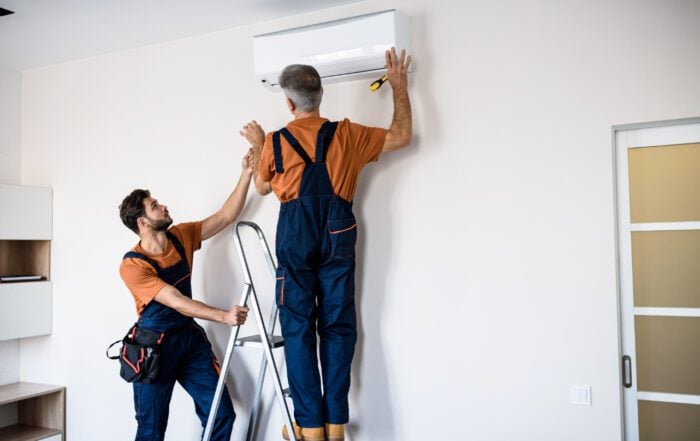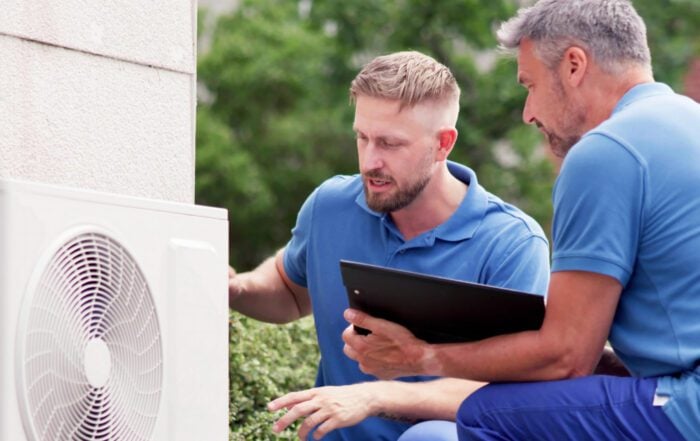Now that we’re a few blustery, frigid months into the midwestern winter, you may have noticed a few things pop up in your home that you didn’t see during the warmer weather. Most noticeably: cold spots.
Cold spots are rooms or areas of your home that don’t heat at the same pace or reach the same temperature as the rest of your home.
Reasons for Cold Spots
1. Bad placement of the thermostat
If you only have one thermostat, a bad location could result in cold spots throughout the home. (Homes with zoning systems will have multiple.) A thermostat has sensors which pick up on the temperature around it to tell the system when to shut off and turn on.
When a thermostat is placed where direct sunlight strikes it for long periods of time, the sensors will pick up on the added heat. This will tell the system that the area is at or above the requested heat, and the heating element will shut off. The same thing will happen if the thermostat is placed too close to a heating vent or on an exterior wall.
Your living room and kitchen may be nice and toasty, but when you go back to the bedroom for the night, you’ll notice a distinct temperature drop.
2. Leaky ducts
It’s also possible that heated air is leaking out of the ductwork before it reaches its final destination. There’s already a degree of heat-loss since ductwork is typically made of metal, so the temperature of the air blowing through it drops as it travels the far parts of the building. When small cracks and gaps develop as well, you lose even more conditioned air.
If conditioned air is spilling out into main rooms, that area will heat up faster. Then, when the thermostat sensors read the requested temperature, they’ll send a message to the furnace or boiler to shut off – whether or not the back rooms have warmed up, creating cold spots.
3. Leaky house
Just like ductwork, your home can have leaks where conditioned air seeps out. When the warm air leaks out of a room that doesn’t have a thermostat, your heating unit doesn’t get a call to adjust for that loss.
4. System is the wrong size
An improperly sized heating unit will blow too much or not enough air through the ductwork. If it’s oversized and is blowing an excessive amount of warm air, the system will shut off before all the rooms in your home can reach the appropriate level.
If the system is undersized, the warm air will not be able to reach the far points of the house, rendering cold spots inevitable. Of course, this also means that it’s overworking itself, and that drives up energy consumption.
5. Improperly zoned home
While not necessary, they can be especially helpful in larger homes. Zoning systems are designed to let you control different areas of your home independently which creates a higher level of comfort and saves on energy consumption. However, if the system wasn’t designed properly (a zone is too large or too small), it can create cold spots.
How to Fix Cold Spots
The good news is that you don’t have to live with these cold spots. There are a variety of ways to solve the problem, depending on where it stems from – and some solutions are more costly than others.
1. Check for blocked vents
This could be anything from furniture blocking airflow to an accidently shut vent. This is obviously going to be the cheapest problem to fix – you’ll want to move any furniture or drapes away from the area and open any closed vent.
This also includes the flue vent. If you use your fireplace – often or sporadically – it’s easy to forget to close the vent once all the coals have cooled down. Cold air can drift in from outside this way, lowering the temperature of the room and creating a cold spot.
2. Look for drafts from windows and doors
A quick way to check for leaks around doors and windows is to hold a lit candle along the frame. If it flickers or bends, add caulk to those areas; this will help to seal out the cold air leaks and prevent cold spots.
3. Think about insulation
If you notice that an exterior wall seems to feel cold all winter long, your insulation may be inadequate. Traditional insulation breaks down over time. If you have an older home, it might be past its lifetime. Spray-in foam is the best option for walls that you don’t want to cut into.
4. Seal the leaks in the ductwork
It is possible to seal the cracks and gaps yourself, but it’s often difficult to find them all. Your best option is to hire a professional to inspect and treat the ductwork.
5. Move your thermostat
This is a fairly simple solution. If your thermostat has direct sunlight hitting it at any point during the day, you want to move it to a location where the warm light won’t disrupt the sensors. If you have a wired thermostat, you may want to consider replacing it with a wireless one. You can easily reposition a wireless thermostat if you see they’re not working in a particular location.
6. Switch to radiant heat
It’s not the most cost-effective solution in the moment, but installing radiant heat in your home can save you in the long run. This type of heating system is comparable to an electric blanket for your home. It can either be installed in the walls or the floor, but flooring-installations are most common.
7. Resize your system
If your heating system is too small or too large for your home, the best thing you can do is replace it with one of an appropriate size. You can try every solution listed above, but you’re still going to get some cold spots if your furnace isn’t sized properly.
If you’ve exhausted all your options and are still experiencing uncomfortable cold spots in your home, contact a professional like Stack Heating, Cooling, Plumbing and Electric. You may need an energy audit to find the exact problem. They’ll also be able to seal ductwork, suggest furnace replacements, and install any new systems you may need.
Have Any Questions?
If this is an emergency please call 440-937-9134.
Otherwise, please feel free to call us or submit this form to schedule an appointment for service or request an estimate. We will contact you shortly!



